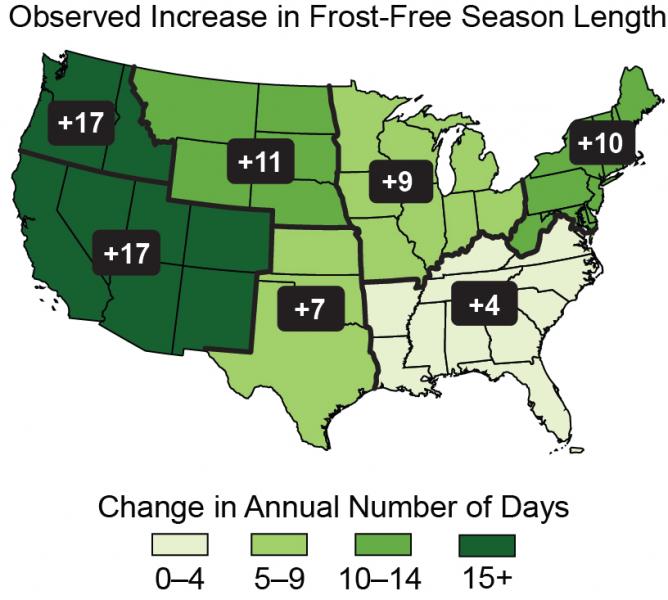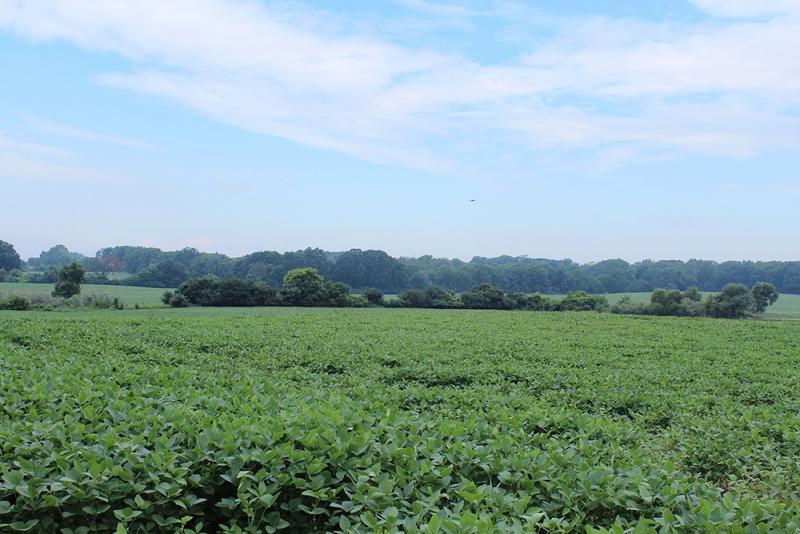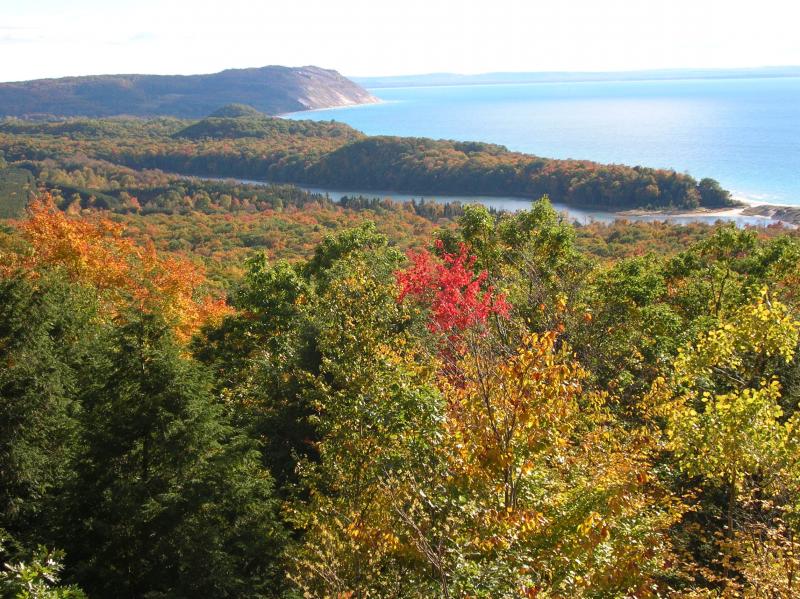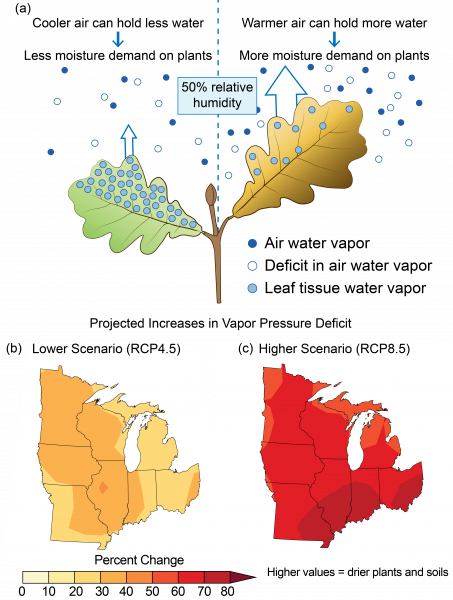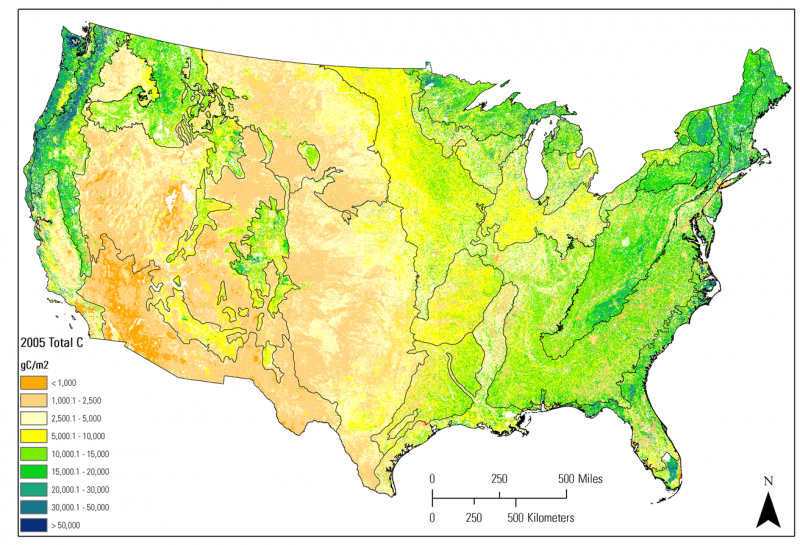Agriculture, Forests, and Ecosystems
Agricultural impacts
Agricultural production represents a significant portion of regional land use and is responsible for a major portion of the Great Lakes’ economy. Crops in the region vary from corn, soybeans, and wheat in the southern and western portions of the region to fruit orchards and vineyards in the northern and eastern portions. Tree fruits such as apples, cherries, and peaches have been a specialty of the Great Lakes region for more than 150 years. Annually, over $1 billion in fruit and nut crops are produced in the eight U.S. states bordering the Great Lakes.
Increased rainfull from April to June, an increase in the frost-free season due to an earlier last spring frost, and increasing humidity are all recent agriculturally important climate trends. The avoidance of heat stress and longer growing seasons have favored agricultural production in some parts of the region in some years. Increased precipitation provides a good supply of soil moisture, but reduces flexibility for the timing of spring planting and increases soil erosion. Increasing humidity has increased daily minimum temperatures in all seasons; an increase in water vapor (absolute humidity) has contributed to growing-season trends in both temperature and precipitation. Higher humidity decreases the day–night temperature range and increases warm-season precipitation. It also leads to longer dew periods and high moisture conditions, which favor many agricultural pests and pathogens for both growing plants and stored grain.
The Great Lakes growing season has lengthened by one to two weeks across the region, primarily due to earlier occurrence of the last spring frost in recent decades. Paradoxically, the frequency of spring freeze events occurring after the initial stages of plant development has increased at the same time, which has resulted in an increased risk of production losses. Future crop yields will likely be affected more by anomalous weather events rather than changes in annual precipitation and annual average temperature alone. Springtime cold air outbreaks are projected to continue to occur throughout this century.
Changing precipitation patterns could also significantly impact agriculture in the Great Lakes. Future projections show that surface soil moisture will likely transition from excessive levels in spring, due to increased precipitation, to insufficient levels in summer, driven by higher temperatures causing more moisture to be lost through evaporation.
Warm-season temperatures are projected to increase more in the Midwest—which includes most of the Great Lakes region—than any other region of the United States. The frost-free season is projected to increase by 10 days by early this century and possibly up to a month by late century, under a higher emissions scenario. Increases in humidity in spring through mid-century are expected to increase rainfall, which will increase the potential for soil erosion and reduce planting-season workdays due to waterlogged soil. Increased spring precipitation and higher temperatures and humidity are expected to increase the number and intensity of fungus and disease outbreaks.
Increases in growing-season temperature in the Midwest are projected to be the largest contributing factor to declines in the productivity of U.S. agriculture. For corn, small long-term average temperature increases will shorten the duration of reproductive development, leading to yield declines—even when offset by increases of carbon dioxide (CO2) stimulation that will likely occur in a warmer climate. For soybeans, yields have a two-in-three chance of increasing early in the near future due to increased CO2 stimulation, but yields will likely decline toward the end of the century due to increased heat stress from an increased number of days with temperatures above 95°F and 100°F.
While the general impacts of climate change on specialty crops are similar to commodity crops, more intense heat waves, excessive rain interspersed with drought, and the higher humidity of a future climate will likely degrade market quality as well as yield by mid-century. Longer growing seasons and the introduction of hoop buildings have allowed local growers of annual vegetable crops to extend the fresh produce season. However, unsheltered perennial crops such as tree fruits may become increasingly subject to early budding followed by freeze, due to earlier and longer occurrences of warm conditions in late winter.
Most animal agriculture in the region is in confinement, rather than range-based without shelter, which offers an opportunity for mitigating some of the effects of climate change. However, without adaptive actions, successful breeding and milk and egg production will be reduced due to projected temperature extremes by mid-century.
The preceding text is excerpted and abridged from the reports Impacts, Risks, and Adaptation in the United States: Fourth National Climate Assessment, Volume II, Chapter 21: Midwest and Synthesis of the Third National Climate Assessment for the Great Lakes Region.
Forest impacts
The northern hardwood forests of the Great Lakes are a defining feature of the landscape and provide numerous economic, ecological, and cultural benefits. Forest-related recreation—such as hunting, fishing, hiking, skiing, camping, wildlife watching, off-highway vehicles, and other pursuits—add to the region's economy. For example, forest-based recreationists spend approximately $2.5 billion (in 1996 dollars) within Wisconsin communities. Forests are also fundamental to cultural and spiritual practices within tribal communities.
Climate change is anticipated to have widespread influence on regional forests over the coming decades. As temperatures rise, reduced tree growth or widespread tree mortality is expected as the frequency of drought stress increases due to drier air (as a result of increases in the vapor pressure deficit [VPD]—see the figure) and changing precipitation patterns. Stress from drought and late growing season heat is projected to shift the composition and structure of forests in the region, warming winters will reduce snowpack that insulates soil from freezing temperatures and protects shallow tree roots, and rising temperatures are anticipated to intensify the effects of insect pests and tree pathogens as winters warm, increasing their winter survival and allowing expansion into new regions. The increasing stress on trees from rising temperatures, drought, and frost damage raises their suspectibility to the negative impacts from invasive plants, insect pests, and disease agents.
Impacts from human activities, such as logging, fire suppression, and agricultural expansion, have lowered the diversity of the region's forests over time; forests with reduced diversity are at an increased risk of negative effects from climate change. In many forests, for example, fire suppression has decreased the prevalence of drought-tolerant tree species such as oak, hickory, and pine, while increasing the abundance of species such as maples, which have higher moisture requirements. As drought conditions increase, this may result in a greater risk of declines in forest health and productivity. As tree species at the northern limits of their ranges decline and southern species experience increasingly suitable habitat, changes in major forest types and composition are projected to occur—with the possibility that the ranges of particular tree species may not be able to shift to future suitable habitats.
Changing climate conditions are increasingly causing forestry-related cultural and economic impacts in the Great Lakes, and these are projected to worsen. For example, many tree species on which tribes depend for their culture and livelihoods—including paper birch, northern white cedar, and quaking aspen—are highly vulnerable due to temperature increases. Warming winters are projected to bring an increase in the emerald ash borer population and increasing mortality of black ash trees, which are important for traditional basket-making for many tribes. Warming winters also have economic impacts on the forest industry. Forest operations (such as site access, tree harvesting, and transport) are typically conducted on snowpack or frozen ground to protect the site from soil disturbance and compaction, but the timing of suitable conditions for these operations has become shorter and more variable, with resulting economic impacts to the forestry industry and landowners through reduced timber sales.
Currently, global forests capture and store more carbon than they emit. With climate change, the ability of forests to act as large, global carbon absorbers (or “carbon sinks”) may be reduced by increases in tree mortality and carbon emission, forest fires, and drought. Some regions may shift from being a carbon sink to a carbon source, although large uncertainties exist. Forests in the Great Lakes region are more resilient to forest carbon losses than most western forests because of relatively high moisture availability, greater nitrogen deposition, and lower wildfire risk.
The preceding text is excerpted and abridged from the reports Impacts, Risks, and Adaptation in the United States: Fourth National Climate Assessment, Volume II, Chapter 21: Midwest, Synthesis of the Third National Climate Assessment for the Great Lakes Region, and State of Climate Change Science in the Great Lakes Basin.
Ecosystems and land cover
The Great Lakes region encompasses a variety of land cover types and ecosystems. Natural ecosystems—including prairies, forests, streams, beaches, dunes, and wetlands that are often rich with varied species of wildlife—are often fragmented by urban and agricultural areas. The combined effects of climate change, land use change, and increasing numbers of invasive species are the primary threats to natural ecosystems in the Great Lakes region.
Species are already responding to environmental changes that have occurred over the last several decades, and rapid climate change over the next century is expected to cause or further amplify stress in many species and ecological systems. Observed changes include species range shifts, changes in population size, shifts in body size and growth rates, and changes in the timing of seasonal events. For example, evidence of shifting ranges comes from Wisconsin forests, where a set of 78 understory plant species sampled in the 1950s and again in the 2000s has demonstrated shifts of about 30 miles over this 50-year period. The dominant direction of the shift was to the northwest, which matches the direction of change in important climatic conditions associated with the distributions of these species. While this shift suggests the potential for successful climate adaptation, the rate at which most species shifted habitats was much less than the amount of climate change over the same time period, raising concerns that the climate is changing too fast for these species to keep up.
Land conversion and other stressors have already reduced biodiversity in many of the region's ecosystems, and high rates of change in climate factors such as air and water temperature and increasing drought risk will likely accelerate the rate of species decline and extinctions. The loss of species and degradation of ecosystems have the potential to reduce or eliminate essential ecosystem services such as flood control, water purification, and crop pollination—reducing the potential for society to successfully adapt to a changing climate.
Ecological impacts of climate change in the Great Lakes themselves occur in the context of multiple stressors. These important ecosystems are already under stress from pollution, nutrient and sediment runoff from agricultural systems, and invasive species. Human influence on habitats is another stressor, including coastal wetland damage and disturbance by human structures that change habitat conditions and water flow patterns. Fisheries and fish management have influences on species populations. Especially in Lake Erie, runoff from agriculture can carry large volumes of nutrients and sediments that can reduce water quality. Increased water temperatures and nutrient inputs also contribute to algal blooms, including harmful cyanobacterial algae that are toxic to people, pets, and many native species.
The preceding text is excerpted and abridged from the reports Impacts, Risks, and Adaptation in the United States: Fourth National Climate Assessment, Volume II, Chapter 21: Midwest and Synthesis of the Third National Climate Assessment for the Great Lakes Region.
To learn more about climate-related impacts on agriculture, forests, and ecosystems, visit Topics. The following topics may be particularly helpful:
